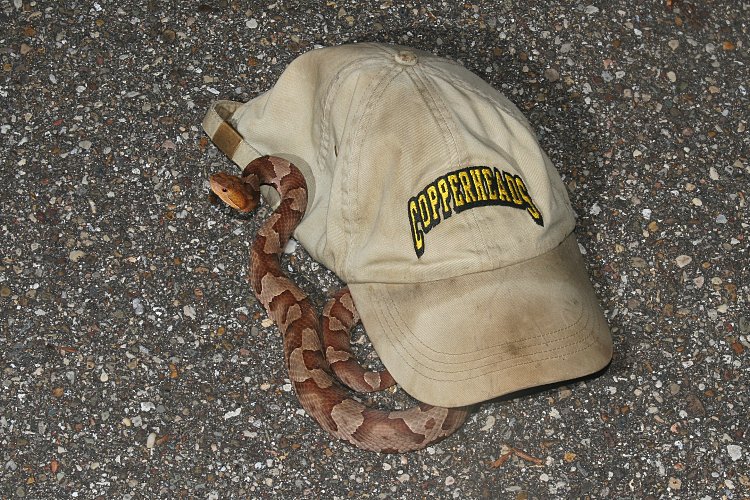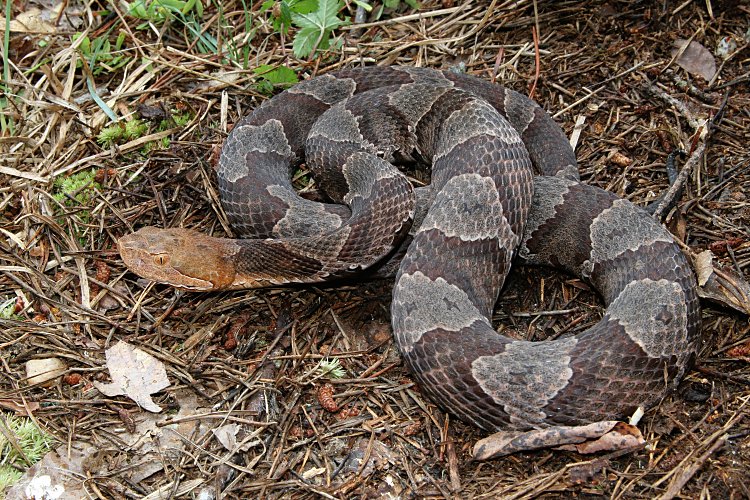So listen up, y'all. If you've ever found yourself wandering through the lush forests of southeastern Ohio and stumbled upon a snake with a striking coppery head, you're probably face-to-face with one of nature's most misunderstood creatures: the southeastern Ohio copperheads. Now, before you start freaking out or reaching for your phone to call Animal Control, let me tell you something. These snakes are not here to ruin your day. In fact, they play a crucial role in maintaining the balance of the ecosystem. But hey, don't take my word for it. Let's dive deeper into their world and uncover some fascinating truths about these slithering beauties.
Now, here's the deal. Copperheads are often painted as villains in the animal kingdom, but they're just doing their thing, minding their own business. They're not out to get you, and they sure as heck don't spend their days plotting world domination. Nope, they're more interested in catching a meal and basking in the sun. But what makes the southeastern Ohio copperheads so special? Well, that's exactly what we're about to find out. So grab a cup of coffee, sit back, and let me walk you through everything you need to know about these incredible creatures.
Before we go any further, let's talk about why understanding copperheads is important. Whether you're a nature enthusiast, a hiker, or someone who simply loves learning about wildlife, knowing more about these snakes can help you appreciate the biodiversity of southeastern Ohio. Plus, it'll make you a more informed and responsible outdoor adventurer. So, are you ready to embark on this journey? Let's get started!
Read also:Snowbound Sw 7004 The Ultimate Guide To Unlocking Its Potential
Understanding Copperheads in Southeastern Ohio
What Makes Copperheads Unique?
Alright, so what makes copperheads stand out in the world of snakes? Well, for starters, they've got that signature copper-colored head that gives them their name. But there's more to these snakes than just their striking appearance. Copperheads are pit vipers, which means they have heat-sensing pits between their eyes and nostrils. These pits help them detect warm-blooded prey, even in the dark. Pretty cool, right?
Now, here's the thing. Copperheads in southeastern Ohio have adapted perfectly to their environment. They thrive in wooded areas, rocky hillsides, and even swampy regions. Their camouflage is second to none, blending seamlessly with the fallen leaves and bark. This makes them masters of stealth, and they often go unnoticed by humans and other animals alike.
The Habitat of Southeastern Ohio Copperheads
When it comes to habitats, southeastern Ohio is a paradise for copperheads. The region's diverse landscapes, including forests, streams, and rocky outcrops, provide the perfect environment for these snakes to thrive. During the warmer months, you'll often find them basking in the sun on rocky ledges or hiding under logs and leaves. As the weather gets cooler, they retreat to dens, sometimes even sharing them with other snake species.
But here's the kicker. Copperheads aren't just limited to rural areas. Believe it or not, they've been spotted in suburban neighborhoods and even city parks. So, if you're out for a stroll in southeastern Ohio, keep your eyes peeled. You never know when you might catch a glimpse of one of these elusive creatures.
Behavior and Characteristics of Copperheads
Are Copperheads Dangerous?
Let's address the elephant in the room. Are copperheads dangerous? The short answer is yes, but here's the thing. They're not aggressive by nature. In fact, they'd much rather avoid confrontation and slither away than bite a human. But if they feel threatened or cornered, they will defend themselves. And let's be real, who wouldn't?
Copperhead bites are rarely fatal, thanks to their relatively mild venom. However, they can still cause pain, swelling, and other unpleasant symptoms. If you ever get bitten by a copperhead, seek medical attention immediately. And remember, prevention is key. Always watch where you're stepping and avoid sticking your hands into places where you can't see.
Read also:Crack Og Pre Workout The Ultimate Gamechanger For Your Fitness Journey
The Importance of Copperheads in the Ecosystem
Now, let's talk about the bigger picture. Copperheads play a vital role in maintaining the balance of the ecosystem. As predators, they help control populations of rodents and other small animals. This, in turn, helps prevent the spread of diseases and damage to crops. So, while they might not be the most popular creatures around, they're definitely doing their part to keep things in check.
And here's another interesting fact. Copperheads are an important food source for larger predators, such as hawks, owls, and even other snakes. This makes them a crucial link in the food chain, ensuring the survival of countless species in southeastern Ohio.
Threats to Copperhead Populations
Human Interaction and Habitat Loss
Unfortunately, copperheads face numerous threats in the wild. One of the biggest challenges they encounter is habitat loss due to urbanization and deforestation. As more land is developed, their natural habitats shrink, forcing them into closer contact with humans. And let's be honest, not everyone is thrilled to meet a copperhead face-to-face.
Another issue is human fear and misunderstanding. Many people kill copperheads on sight, believing them to be dangerous pests. But the truth is, these snakes are just trying to survive in a rapidly changing world. By educating the public about copperheads and their role in the ecosystem, we can help protect these incredible creatures for future generations.
Conservation Efforts for Copperheads
Thankfully, there are organizations and individuals working hard to protect copperhead populations in southeastern Ohio. Conservation programs focus on preserving natural habitats, educating the public, and conducting research to better understand these snakes. By supporting these efforts, we can ensure that copperheads continue to thrive in the wild.
One of the most effective ways to help copperheads is by creating snake-friendly environments in your own backyard. This can include providing shelter, such as piles of rocks or logs, and avoiding the use of pesticides that harm their prey. Small actions like these can make a big difference in the lives of these fascinating creatures.
Interesting Facts About Copperheads
Here are some fun facts about copperheads that might surprise you:
- Copperheads are one of the most common venomous snakes in North America.
- They can live up to 18 years in the wild.
- Female copperheads can reproduce asexually in a process called parthenogenesis.
- They're often mistaken for other non-venomous snakes, such as the northern water snake.
- Copperheads are more active during the warmer months, typically from April to October.
How to Identify a Copperhead
Physical Characteristics
Identifying a copperhead can be tricky, especially if you're not familiar with their distinctive features. Here's what to look for:
- A coppery-colored head (hence the name).
- A thick, muscular body with a distinct hourglass pattern.
- Vertical pupils, similar to a cat's.
- A triangular-shaped head.
- Heat-sensing pits between their eyes and nostrils.
But here's a pro tip. If you're not 100% sure whether a snake is a copperhead or not, it's best to keep your distance and err on the side of caution. After all, it's better to be safe than sorry.
Living Harmoniously with Copperheads
Now that you know more about copperheads, let's talk about how to coexist peacefully with these snakes. First and foremost, respect their space. If you encounter a copperhead in the wild, give it plenty of room to move away. Avoid making sudden movements or trying to handle the snake, as this could provoke a defensive reaction.
Another important tip is to keep your yard tidy. Removing piles of debris, trimming overgrown vegetation, and sealing gaps in your home can help deter copperheads from taking up residence in your backyard. And if you're a fan of outdoor activities, always wear sturdy shoes and carry a flashlight when hiking at night.
Conclusion: Embracing the Copperhead
So there you have it, folks. The southeastern Ohio copperheads are more than just snakes; they're vital members of the ecosystem who deserve our respect and understanding. By learning more about these fascinating creatures, we can break down misconceptions and foster a greater appreciation for the natural world around us.
And hey, don't forget to share this article with your friends and family. The more people know about copperheads, the better equipped we'll be to protect them. Who knows? You might even inspire someone to become a snake enthusiast themselves. So, what are you waiting for? Spread the word and let's make a difference together!
Table of Contents
- Unveiling the Mysteries of Southeastern Ohio Copperheads: A Closer Look
- Understanding Copperheads in Southeastern Ohio
- What Makes Copperheads Unique?
- The Habitat of Southeastern Ohio Copperheads
- Behavior and Characteristics of Copperheads
- Are Copperheads Dangerous?
- The Importance of Copperheads in the Ecosystem
- Threats to Copperhead Populations
- Human Interaction and Habitat Loss
- Conservation Efforts for Copperheads
- Interesting Facts About Copperheads
- How to Identify a Copperhead
- Physical Characteristics
- Living Harmoniously with Copperheads
- Conclusion: Embracing the Copperhead


